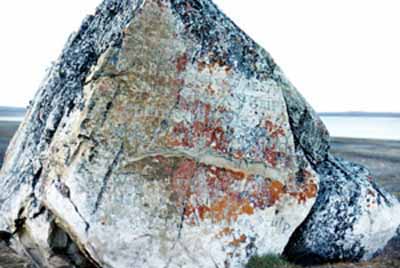Parry's Rock Wintering Site National Historic Site of Canada
Winter Harbour, Melville Island, Northwest Territories

View of Parry's Rock
© Parks Canada Agency / Agence Parcs Canada, 1976.
Address :
Winter Harbour, Melville Island, Northwest Territories
Recognition Statute:
Historic Sites and Monuments Act (R.S.C., 1985, c. H-4)
Designation Date:
1930-05-16
Dates:
-
1819 to 1820
(Significant)
Event, Person, Organization:
-
William Edward Parry
(Person)
-
Dr. J. Fisher
(Person)
Other Name(s):
-
Parry's Rock Wintering Site
(Designation Name)
Research Report Number:
1971-020, 2006-CED-SDC-024
Description of Historic Place
Parry’s Rock is a large sandstone rock, approximately 5.5 metres long and 3 metres high, located at Winter Harbour, Melville Island, N.W.T. (latitude 74°46’00” N, longitude 110°38’00” W). The top of the rock is 52 feet above sea level. The rock contains a number of carvings and a plaque mounted in 1909.
Heritage Value
Parry’s Rock Wintering Site National Historic Site of Canada was designated in 1930 because: it records an early and important attempt to discover the Northwest Passage by the expedition under William Edward Parry in 1819-20.
Parry’s 1819 expedition arrived in the area in mid-September and spent the winter in Winter Harbour. Before leaving the area, the ship’s surgeon, J. Fisher, inscribed the names of the two vessels, Hecla and Griper, and their captains on the large sandstone rock located on the beach. Parry continued on, sailing farther west, but was stopped by ice near Cape Dundas. Had he been able to sail on through the McClure Strait he would have entered the Beaufort Sea and been able to pass through the Bering Strait to the Pacific. Parry’s expedition had demonstrated that Lancaster Sound opened a passage towards the west that later explorations would show was the Northwest Passage.
Source: Historic Sites and Monuments Board of Canada, Submission Report and Minutes, October 2006.
Character-Defining Elements
Key elements contributing to the heritage value of this site include: the condition and location of Parry’s Rock; the existence of the carvings by J. Fisher and others relating to exploration in the Arctic, and the commemorative plaque.